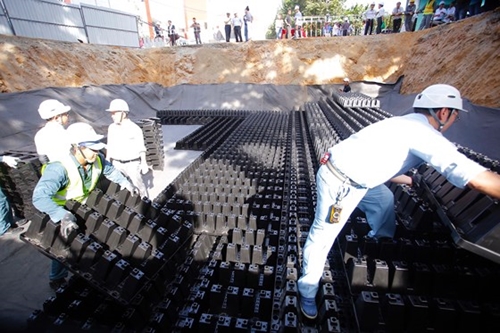Nguyen Hoang Anh Dung, deputy director of the centre, said the first reservoir on Vo Van Ngan Street in Thu Duc district had been successfully trialled and it proved as effective as expected.
Completed last August, it can contain 109 cubic metres of water.
Dung said streets in the area used to be frequently under 10-15cm of water it the rainfall reached 30 mm before the reservoir was built.
“After the reservoir was built, flooding has decreased significantly in terms of frequency, severity and area. It now takes rainfall of over 60mm to cause floods," he said.
The centre has conducted a survey and hired a consultancy to make plans for building similar reservoirs in flood-prone areas in five districts.
The locations are Hoang Van Thu Park in Tan Binh district, Go Vap Floral Park Village in Go Vap district, a culture park in District 10, the central reservation on Phan Xich Long street in Phu Nhuan district, and the area between the Ward 15 police station and Alley 48, Dien Bien Phu street, Binh Thanh district.
    |
 |
|
The underground water reservoir using Japanese Crosswave technology on Vo Van Ngan Street in HCM City’s Thu Duc district has been built and proved efficient in reducing flooding |
With a combined designed capacity of 1,500-20,000 cubic metres, pumping stations and garbage collection systems, they will cost an estimated 475 billion VND (20.5 million USD) to build.
“When the reservoirs are built, people living in flood-prone areas will not suffer flooding any more,” Dung said.
He said using Crosswave technology has many advantages like withstanding vehicles of over 25 tonnes weight and having 95 per cent of reservoir capacity for water storage.
“This is an effective solution when land in the city is limited.”
"It does not affect traffic flow or cause pollution, Crosswave modules can be reused and easily moved away in case of need," he said.
“Besides reducing floods, the underground reservoirs can store and supply water for irrigation and firefighting.”
Districts have supported the centre’s plan but are still undecided about the locations and modalities.
They said their ability to source new technologies was limited and so the centre should hand over the work to an investor to ensure efficiency.
District 10 sought details of how the technology works.
Ho Phuong, deputy chairman of the People’s Committee of Binh Thanh district, said it would not be feasible to build an underground reservoir on Dien Bien Phu street as proposed.
"Besides, it is not a flood-prone area," he said.
He suggested moving the reservoir to Alley 135 on Nguyen Huu Canh street, which is frequently flooded during rains.
The Tan Binh District People's Committee also called for reconsidering the Hoang Van Thu Park location.
Dung said the centre and the Department of Planning and Investment would ask competent authorities to approve funds to complete the work in 2016-20.
Source: VNA